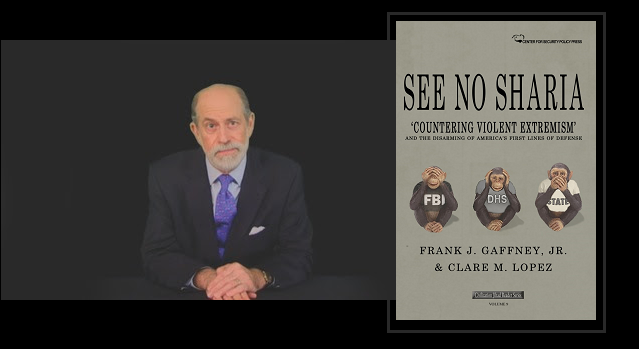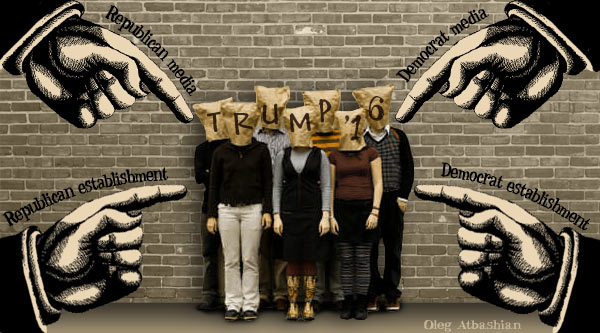TRUMP supporters are, perhaps, the only group of voters in America’s history who have been so viciously and consistently maligned, and in such a coordinated manner, by both political parties.
At the same time, not much is known about them, despite the recent spate of articles attempting to explain the phenomenon. The problem with that is that the authors admittedly don’t know any of the Trump supporters themselves. Well, I happen to know quite a few of them personally.
Full disclosure: first, I can’t vote because I’m not a US citizen yet, despite my best and decades-long efforts — but let’s leave the immigration system’s misplaced priorities for another day.
Second, I like to form my opinions about the candidates and their supporters independently, without taking advice from media pundits or Facebook messages from pro-Cruz acquaintances.
Third, I like both Cruz and Trump. I’m not as passionate about them as some; I’m merely pragmatic: I like anyone who can stop America’s descent into socialism or, better yet, reverse the course entirely. I also realized that America has come to a point when having big ideas is no longer enough; in order to shake up the system and get the economy moving the next president must also be a bigger-than-life mover and shaker.

Oleg in Ukraine in the early 1980s. Source: Supplied

Oleg Atbashian. Picture: Larissa Scott
Since I’m not allowed to vote, I remain simply an objective observer of American politics, judging the process from the perspective of a former Soviet citizen, who during the times of the glorious Union of Soviet Socialist Republics was forced to cast single-name ballots for candidates I didn’t know nor cared about. A total 100 per cent voter turnout in practice meant total apathy: most people dropped paper ballots into the boxes without reading them.
The occasional rare signs of passion were the ballots with crossed-out names and large capital letters saying, BLOODSUCKERS ALL; those were extracted by the KGB for handwriting analysis. Voting had become a periodic ritual of obedience and surrender before the powerful state and a reminder that we were all equal slaves in the eyes of our masters.
That memory makes American elections even more interesting. First it’s the primaries, where candidates from each political party position themselves in a circular firing squad, trying to assassinate each other’s character and reputation.

Photo: Business Insider
Once only a few of them remain standing, their supporters start fighting and demonizing each other on social media to the point where to an objective observer every candidate looks like the most corrupt and immoral scoundrel and the worst human being who ever lived.
Finally, the two surviving candidates from each party, badly wounded and bloodied, begin to punch each other in the wounds during the general election, as their supporters continue to fight and demonize each other on social media. The one who still stands by November is then declared Leader of the Free World.
At least that’s how most foreigners see it, especially if they are unfamiliar with the differences between the two parties and get their facts from the mainstream media which always promotes one party and pretends to be fair to the other.
Democracy is the worst form of government, except for all the others, said Winston S. Churchill, and he had his own political wounds to prove it.
This year’s election especially fits the above caricature. The strongest fire from all media portholes and loopholes is directed at the Republican frontrunner, Donald Trump, and his supporters. They are being described as uneducated, angry, vengeful, racist, xenophobic, and plain stupid. Authors of these assumptions, mostly writing from within the Boston-New York-Washington corridor, admit that they don’t even know anyone who likes Trump.
But how can they write about what they don’t know? When the electoral map is fluid, when things are happening rapidly in real time, and when no reliable historical data exists, we rely on personal experiences and anecdotal evidence.
In the absence of such, the writers simply fill the gaps in their knowledge with their own prejudices, similar to how medieval mapmakers marked unexplored areas with “here be dragons.”

Supporters listen to Donald Trump at a campaign rally in Davenport, Iowa. AP Photo / Charlie Neibergall.
There’s a big probability that Trump supporters are, in fact, all around them, even in their own families — and the reason why these writers don’t know it, is their own snobbery.
No one likes to be called stupid, his IQ questioned, or presumed to be an unthinking herd animal, and many simply don’t have the time to stop and explain their reasons whenever a #NeverTrump activist feels like trashing Trump voters. Many simply choose to remain silent.
This study explains why many polls underestimated Trump’s support: Trump has consistently polled better on anonymous online polls than on phone surveys because some of his supporters were unwilling to identify themselves publicly. In other words, public shaming didn’t unwean Trump from his supporters but caused them to go underground.
Doesn’t this also describe how the majority of Americans have felt in recent decades, being constantly shamed into silence by the “progressive” media, education, and the cultural establishment?
I know this too well, having worked in New York’s “progressive” corporate environment. My co-workers would ask me about life in the USSR and I would tell them exactly what I thought about socialism and political correctness until I realized that most of them didn’t like my answers and I was only hurting myself by speaking my mind.
Some gave me frightened looks, others stopped talking with me. I might as well have told them that life in the USSR was similar to life in New York, where people had to learn to keep their mouths shut and to look over their shoulders before saying anything remotely political. So much for emigrating into a free country. It felt like history was about to repeat itself. Until now.
Consider this story: there lived an apathetic silent majority, maligned and shamed by its leaders and the official media, and they thought it would never end.
But one day a miracle happened: they suddenly heard a voice that articulated their own forbidden thoughts — something they had been afraid to articulate in public, even though it was common sense — words not dressed in flowery rhetoric and rounded sentences, but delivered roughly, in a regional accent of the common man — plain and truthful words coming from the highest pulpit in the nation.
Millions of people recognized their own voices in his, lending him their support — silently at first, but more and more vocal as time went by — to a point that they went out into the streets to defend him in the face of violent and dangerous opposition from the far Left.
I am talking, of course, about Mikhail Gorbachev and the reaction he first received from the Soviets when he started his Perestroika and Glasnost in the USSR. I remember it clearly because I was one of them.
Gorbachev wasn’t perfect by any measure, and yet he started a process that shook up the corrupt establishment, ended the rule of the powerful Communist Party, liberalized the economy, and opened the country to an honest debate about its problems.
The parallels with Donald Trump, his message, and his appeal with America’s silent majority are unmistakable.
That the Soviet Union’s problems turned out to be irreconcilable wasn’t Gorby’s fault; the country had already been damaged beyond repair by seven decades of ruthless socialist experimentation.
America hasn’t yet gone that far, but the wild popularity of socialist Bernie Sanders with the “screaming minority” of young voters may be an indication that this election may be America’s last exit before the road ends off a cliff.
Giving voice to the silent majority is one of the factors why Trump leads in the race. Some other factors will become clear if we look at some of his individual supporters. I know who they are because they aren’t afraid to open up to me.
They know that unlike the above established essayists, I won’t be calling them names or trying to shame the silent majority back into silence. For the same reason I’m not using their real names.

Soviet President Mikhail Gorbachev makes a point to News Corporation chief executive Rupert Murdoch during the latter’s Kremlin visit in Moscow, 1991. Source:Supplied
JACK
Jack is an accomplished classical musician, a fine wordsmith, a long-time conservative, and a devout Christian. When a broken shoulder made him unable to hold the instrument, he used his sharp, perceptive mind and his degree in economy to make himself a fortune in the financial markets. Now he can afford to relax and write novels.
Jack gave me his take on the demonetization of Trump and the stereotyping of his supporters as poorly educated, low-information rubes.
According to Jack, both the Republican and the Democrat establishments are corrupt and dysfunctional, but the one thing they can do well is manufacture media narratives that infect people’s minds with notions that are beneficial to the respective branch of political aristocracy, while causing aversion to anything that endangers it.
Trump is a clear and present danger to this corrupt and elitist system. He is willing and fully able to blow to smithereens all their carefully established social hierarchies and to change the entire political culture, which will make the elites unnecessary and expose the uselessness of their cherished and very expensive apparatus.
The GOP establishment’s fear and loathing of Trump is so intense that even losing the election to Hillary seems to many of them a lesser evil.
The same establishment remained ineffective throughout the Obama presidency. Obama didn’t threaten their careers and each one of his disastrous policies was to them a lucrative fundraising opportunity.
In contrast, Trump threatens their very survival — and suddenly the establishment’s speed and effectiveness is phenomenal. Their quickly constructed #NeverTrump narrative is targeting conservative “purists” and die hard Ted Cruz supporters, infecting them with hostility that reaches and surpasses the ill-famed Bush Derangement Syndrome.
The sad irony of the #NeverTrump movement is that these self-proclaimed “true conservatives” and “anti-establishment rebels” have swallowed the establishment’s narrative hook, line, and sinker.
Worse yet, they now indiscriminately share social media links from previously despised leftist sources, as long as they attack Trump. So much for their stereotyping of Trump supporters as gullible, angry jerks.
Jack isn’t a Cruz-hater. In fact, he would just as much like to see Ted Cruz become president, if he can win in the general election — which is unlikely. Like most Trump supporters I know, Jack doesn’t treat other candidates with the same hostility.
There’s no organised #NeverCruz movement to speak of, and no one except Cruz supporters are creating blacklists targeting the other side. Jack is sad to see that so many good, previously sane people have succumbed to the #NeverTrump lunacy.

Supporters shout for Democratic presidential candidate Bernie Sanders as he speaks at a campaign rally Monday, April 11, 2016, in Buffalo, New York. Picture: Mel Evans/APSource: AP
MIKE
My other friend, Mike, who is a conservative writer, approaches this from a different angle. He likes Ted Cruz because Cruz has all the right answers, but that’s not enough. Mike compares Cruz to a professor who can recite the chemistry textbook by heart.
Trump, on the other hand, is a wild man who wants to use the formulas in that same textbook to blow away our enemies. At this point in history we don’t need a professor, we need the wild man.
BRENDAN
Brendan is an immigrant from Ireland, who says that when he came to the U.S., he expected to see an American leader to be more like John Wayne — a decisive and confident guy with swagger — and not like Pee Wee Herman or a European-style spineless socialist.
Brendan has spent years working on New York construction projects, including some that involved Donald Trump. He witnessed Trump getting personally involved with contractors and workers without any mediators, not afraid to get dirty and drive a hard bargain.
Trump has never lost his lower-class accent he picked up growing up in Queens, and he was never accepted by the snooty New York elites as their own. But he has always been liked and accepted by the working classes as a “people’s billionaire.”
He doesn’t see anger among Trump’s supporters, but rather optimism and love for the country. He also scoffs at those who compare Trump to Mussolini or Hitler. Trump has been in the public eye for almost 70 years, running a large business, producing a TV show, and nobody ever complained about him acting like a despot.
Don’t you think that if Trump had the slightest trace of a dictator in him, someone would have brought it up and the media would have trumpeted it all over the world?
Brendan also likes Ted Cruz and shares many of his ideas. But even if Cruz is president, says Brendan, he’ll be lucky if he’s able to implement at least 10 per cent of those ideas in practice.
Trump, with his ability to overcome obstacles, will probably get at least 70 per cent done. Brendan may not share 100 per cent of Trump’s ideas, but he would rather see 50 per cent of them implemented by Trump than 10 per cent by Cruz, or 0 per cent by Bernie or Hillary.

Democratic presidential candidate Bernie Sanders reacts to a fist waving supporter as he speaks at a campaign rally Monday, April 11, 2016, in Buffalo, New York. Picture: Mel Evans/AP Source: AP
ANN
Ann has recently parted with feminism and quit the National Organization for Women (NOW) over what she describes as the betrayal of women’s rights by feminist leadership.
The politically correct, leftist feminist establishment has done nothing to oppose the oppression of women in Sharia-dominated societies, and continues to oppose any attempt to prevent the spreading of the patriarchal and misogynistic Sharia values through Muslim immigration in America. In Ann’s words, by supporting pro-Sharia multiculturalism, NOW effectively sided with male chauvinists over women’s rights.
Ann isn’t buying the divisive argument that Trump is anti-women, saying that giving women special allowances because of their gender is condescending.
You can’t eat cake and have it, too. If you demand equal treatment, be ready for equal treatment. One can’t beat Hillary if one is too concerned with sparing her feelings. We are all adult individuals.
While fighting patriarchy in our society, she says, the radical leftist feminists went too far and destroyed manhood itself, along with fatherhood. It’s bad for the families, for the children, and especially for women.
Ann sees Trump as a successful male role model and a father figure. If he weren’t one in real life, his own children wouldn’t have turned out so well.
The Left has emasculated our men, she says. Fathers in popular culture changed from “Father Knows Best” to Homer Simpson: the butt of all jokes and the last to get the joke.
Fatherless children who grew up watching The Simpsons are father-hungry. Trump, she says, will be like the dad who comes home to an out-of-control house party, makes the kids clean up, kicks out the troublemakers, and sues their parents for damages.

Republican presidential candidate Ted Cruz addresses a rally at the Town and Country Resort and Convention Center on April 11, 2016 in San Diego, California. Picture: Bill Wechter/AFP Source: AFP
Ann sees today’s emasculated warrior class, with new recruits using time-out cards if under too much stress, and she is worried about their ability to defend us.
She sees the European “men” who do nothing to protect their women or their nations from organised, systemic rape by Sharia-fuelled “guests,” and predicts that will happen to us, too, if we don’t change course.
She sees the spineless millennials wishing for Bernie Sanders to ensure their perpetual childhood, and she blames the leftist education for crippling their minds and souls. The worst part is that these young doormats hate, not those who disabled them, but those who keep spines intact.
Ann believes we have entered the age of fear and denouncements, where anyone with a spine is automatically perceived as a fascist, racist, homophobe, Islamophobe, and so on.
Trump is giving American men permission to be men again, to say what they think, and to stand tall without guilt or fear, says Ann. She quotes Billy Graham: “Courage is contagious. When a brave man takes a stand, the spines of others are often stiffened.”
No wonder Graham’s son endorsed Donald Trump. With Trump as president, a new generation of Americans will have a chance to grow up having a spine, with a positive male role model to compensate for their fathers who are either missing or have been neutered. His campaign slogan may as well be, “Men! Take back thy manhood!”
After seven painful years of watching our Commander-in-Chief bunny-hopping down plane and helicopter steps, struggling to lift one-pound barbells, girl-throwing first baseballs in mom jeans, and dressing up in little cowboy outfits, the country needs a masculine reset.
The return of a strong, manly man to our culture will be great news for women, who have grown tired of being single-income mothers, leaders, fighters, and protesters, Ann says. And America will have a chance to get back its emotional and psychological health, confidence, optimism, and positive disposition that’s been missing for too long.
COLIN
Colin had a successful international career as a dancer and choreographer, ranging from performing and teaching classical ballet to modern dance, from acting on Broadway to choreographing dances for some of the most famous pop stars, whose names I’m withholding for obvious reasons.
In case anyone is wondering, Colin is not gay and lives with a long-time girlfriend. He also has a sizable collection of guns, likes hunting and fishing, and drives an SUV. Having been to every corner of the earth, he retired and became my neighbor here in Florida, where we became good friends and have spent many evenings playing music and sharing stories.
Colin never spoke about politics and whenever I or anyone else touched on that subject, he would start singing some silly tune in a loud, raspy voice, ending any possible debate.
That was until this summer, when he decided to support Donald Trump. Not only did he tell this to all his friends and neighbors, some of whom were die hard liberal leftists; he also called everyone in his phone book, encouraging them to vote for Trump as well, thus becoming an unaffiliated Trump campaign volunteer.
His reason for the sudden change of heart was that for the first time in his life he heard a presidential candidate whose words made perfect sense. All the others, according to Colin, were trained weasels giving rehearsed performances, which he could instantly spot with his professional background.
Unlike the rest, Trump spoke off the cuff, didn’t mince words, called things by their real names, and used strong language when necessary, unconcerned about what society and the media would say about that behind his back. I couldn’t help noticing that, in a way, Colin was describing himself. If he were ever to go into politics, he would’ve done it pretty much the same way, except for the hairstyle.

Donald Trump holds up a sign handed to him by a supporter after speaking at a campaign rally, Wednesday, April 6, 2016, in Bethpage, New York. Picture: Julie Jacobson/AP Source: AP
CHRISTINA
Christina has a PhD in literature, but her academic career ended when she evolved from a liberal into an outspoken conservative. All her previous activism in helping the inner city families, being involved in refugee resettlement programs, working with the ACLU, and other liberal credentials didn’t matter anymore.
She became an untouchable and soon lost her job. Since then she has been active in local Republican politics and Tea Party circles, exposing the rot in America’s education system, fighting Common Core, and organising book tours for conservative authors.
She sees Trump as the only candidate who is not buying into the neurotic identity politics that’s currently driving both political parties.
In her experience, identity politics and political correctness are the drivers of fascism in America today. In that sense, Trump is the most anti-fascist candidate in the race — and the most optimistic one, too.
The first Trump rally she attended was different from all other political events she has seen, which usually attract party regulars and the party elite. The people in this crowd weren’t very political; many of them first-timers — those who don’t live and die over the latest little fluff-up in DNC or the GOP or even the Tea Party. Christina thought that was very significant.
There were old people, young families, teenagers, blacks, whites, and a good number of Southeast Asians. This was in Norcross, Georgia, which has one of the most ethnically varied populations in the South and maybe even the U.S.
It’s a major refugee placement site and also attracts immigrants from India, Asia, and Africa. So there are a lot of immigrant entrepreneurs and small business owners in Norcross, and she saw a lot of that actual diversity — including economic diversity — in the crowd, says Christina.

Donald Trump greets supporters during a rally at Memorial High School in Eau Claire, Wisconsin, Saturday, April 2, 2016. Picture: Marisa Wojcik/The Eau Claire Leader-Telegram via AP. Source: AP
She doesn’t understand how anyone in the GOP could be so recalcitrant as to not see this as an extraordinary opportunity to grow the GOP brand. Trump alone has the ability to move people towards conservatism: doesn’t the GOP get that? Christina sees Trump as an object lesson in moving towards conservative values in his own life, and he can move other people in the same direction.
She objects to the description of Trump supporters as angry. There was no love lost for either political party or for the media in that crowd, she says, but the people weren’t angry at all: they were optimistic. It was the sort of optimism people felt when Reagan was elected.
Trump’s message was patriotic and positive, praising America’s virtues and the value of hard work and self-sufficiency. It’s sad that the Republican Party couldn’t see the extraordinarily positive message Trump was delivering, and the positive spirit with which it was received.
At that moment, the election could have been in the GOP’s hands, had they not launched a coordinated assault on Trump and his followers.
The editors at National Review and others of their ilk ought to be on their knees celebrating their good luck that someone like Trump has come along at this particular moment in American history. But instead, they’re so angry they’re overturning their sandboxes and pitching tantrums, she says.
Imagine how different this race would be if the GOP hadn’t tried to salt the earth around Trump and his supporters, says Christina. She believes that if they had only remained neutral, the party would currently be growing by leaps and bounds.
The very landscape of the electorate would be shifting towards conservatism and away from liberalism. But it was more important for the party elites to control people than to listen to them.
EDITORS NOTE: This article originally appeared in American Thinker and was reproduced with permission. The featured image is courtesy of VictoryGirlBlog



 For much of the past fifteen years, the United States government has failed to understand, let alone decisively defeat, the enemy that, under the banner of its al Qaeda franchise, murderously attacked our country on September 11, 2001. The reason why that has been so – notwithstanding the bravery and skill of our men and women in uniform and the expenditure of hundreds of billions of dollars – has been unclear to most Americans, including some in government. Until now.
For much of the past fifteen years, the United States government has failed to understand, let alone decisively defeat, the enemy that, under the banner of its al Qaeda franchise, murderously attacked our country on September 11, 2001. The reason why that has been so – notwithstanding the bravery and skill of our men and women in uniform and the expenditure of hundreds of billions of dollars – has been unclear to most Americans, including some in government. Until now.




 Meanwhile, reports out of the Middle East indicate a growing concern of Iran’s activity. From Yemen to Iraq to Gaza, Iran continues to fund and arm terrorist insurgencies that are reshaping the region. Not only Israel, but the Gulf states and their Sunni allies are preparing for potential confrontation. Barack Hussein Obama’s “nuclear deal” has only emboldened Iranian ambitions, and caused tradition U.S. allies to lose faith in the United States dedication to peace and stability in the M.E.
Meanwhile, reports out of the Middle East indicate a growing concern of Iran’s activity. From Yemen to Iraq to Gaza, Iran continues to fund and arm terrorist insurgencies that are reshaping the region. Not only Israel, but the Gulf states and their Sunni allies are preparing for potential confrontation. Barack Hussein Obama’s “nuclear deal” has only emboldened Iranian ambitions, and caused tradition U.S. allies to lose faith in the United States dedication to peace and stability in the M.E.















 In March we posted a political satire column titled “
In March we posted a political satire column titled “ It appears that political satire has become politically correct policy at DePaul University.
It appears that political satire has become politically correct policy at DePaul University. 





 BETHESDA, Md.
BETHESDA, Md.